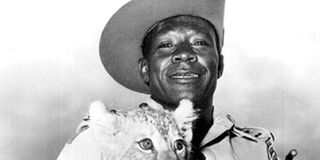Exit army chief who wanted to be president

PHOTO | FILE
What you need to know:
- What could have driven Maj-Gen Ndolo and his co-conspirators to think of toppling Kenyatta?
- The euphoria of independence had mostly evaporated as an increasingly frail Kenyatta fell out with many of his comrades-in-arms
- Early in the same year, a precedent had been set in neighbouring Uganda with Ndolo’s counterpart, Idi Amin, ousting President Milton Obote
In June 1971, 13 men were tried and jailed for conspiracy to overthrow the government of Jomo Kenyatta.
They were a collection of civilians and soldiers. Although he was not among those in the dock, Maj-Gen Joseph Ndolo, the head of the military, was said to have been the man behind the plot and the one designated as president had it succeeded.
Chief Justice Kitili Mwendwa was caught in the web and was forced out of office but was also not charged.
Maj-Gen Ndolo, the first African Chief of Defence Staff (CDS), quietly resigned from office shortly after his co-conspirators were jailed.
Born in 1919, Maj-Gen Ndolo had been recruited into the King’s African Rifles, and at independence, he was a high ranking officer within the newly-established Kenya Army.
When he was appointed army commander in 1966, the newly-created position of Chief of Defence Staff was held by Major-General Penfold, a British officer.
Ndolo’s rise to the top was linked to the 1964 Lanet mutiny. The mutineers had demanded, among other things, the Africanisation of the top echelons of the military.
“Although Kenyatta retained a British general as army commander–in-chief for two more years, by the end of 1964, Africans held all of the executive positions in frontline units,” Timothy Parsons writes in Military Unrest And National Amnesia In Kenya.
Ndolo was the president of the military tribunal that tried the 1964 mutineers. Joseph Daniel Owino, one of the 1971 conspirators, was discharged dishonourably for his role in the Lanet mutiny.
Yatta MP Gideon Mutiso, one of the 13 tried, said in court that he had written a proclamation letter that Ndolo was to have read out after overthrowing the government. It would state the reasons the military would stage a coup. “…Had it not been for the constant assurances of Ndolo that there was every possibility of succeeding in the plot, I would not have taken part in it…” Mutiso said.
In an interview with the Daily Nation in 2009, Gen Jackson Mulinge, who was army commander and took over from Ndolo, said he had been approached by his boss to back the coup. Mulinge implies that he saved Kenyatta by turning down Ndolo’s approach but also helped to dissuade the president from arresting Ndolo over the plot.
“Soldiers are trained to take orders from their superiors. In this case Ndolo is their commander. To arrest Ndolo you can’t send some junior officers to do so. You are inviting a mutiny Mr President,” Mulinge said he told Kenyatta.
For a man reputed for his ruthlessness, Kenyatta approached the 1971 coup attempt with utmost delicacy.
The plotters were tried for a lesser charge of sedition, which carries a jail sentence, rather than treason, which carries the death penalty.
Maj-Gen Ndolo was eased from office with full benefits.
He died on April 6, 1984 in a road accident while driving alone from Mombasa to his home in Sultan Hamud.
MOTIVE
What could have driven him and his co-conspirators to think of toppling Kenyatta?
Historians point at two main factors.
First, the euphoria of independence had mostly evaporated as an increasingly frail Kenyatta fell out with many of his comrades-in-arms led by Jaramogi Oginga Odinga. In its short period as an independent nation, Kenya had been hit by a series of potentially destabilising political assassinations, including those of Pio Gama Pinto and Tom Mboya.
Two years before the conspiracy, Odinga had been detained and his Kenya Peoples Union party banned.
The detention had been preceded by the 1969 Kisumu riots in which 11 people had been killed.
A clampdown on critics had been launched as the central Kenya power barons that surrounded the president consolidated their grip on the state to the exclusion of others.
Secondly, early in the same year, a precedent had been set in neighbouring Uganda with Ndolo’s counterpart, Idi Amin, ousting President Milton Obote.
Dr Obote, who had himself fallen out with Kabaka Mutesa, was being accused of the same ills confronting Kenyatta.
The arrest, trial, and conviction of the conspirators sparked massive rallies around the country to re-affirm loyalty to the Kenyatta administration.
Mr S.K Sachdeva, then acting senior resident magistrate, convicted the plotters on their own plea of “guilty”.
During prosecution, the accused confessed that the plotting for the putsch, which was to happen on April 8, took place in Ukambani, Kampala, and Dar es Salaam.
Mr Mutiso was the chairman of the Revolutionary Council, the political arm of the plotters, while Mwendwa, the CJ, would have sworn Ndolo into office as president.
HEATED DEBATE
Mwendwa resigned on July 7 after heated debate in Parliament started by Githunguri MP Arthur Magugu, who sought a government statement on what he knew about the plot.
After the debate, Kenyatta supporters demonstrated with placards calling for the CJ’s resignation.
But how did the plot leak?
Evidence in court pointed to possible weak links Mr Mutiso said he had shown the proclamation he had been asked by Maj-Gen Ndolo to write to a colleague in Parliament. The second point could have been intelligence reports from Kampala and Dar es Salaam.
Prof Ouma Muga, the first accused, was said to have been coordinating from Makerere University, where he was teaching.
Joseph Daniel Owino, the seventh accused, was in Dar es Salaam.
Maj-Gen Ndolo, it was said, held 12 “goat-eating” meetings to plot the coup in his Makueni home. Then, of course, there was Mulinge, whom Ndolo had tried to recruit into the plot.


